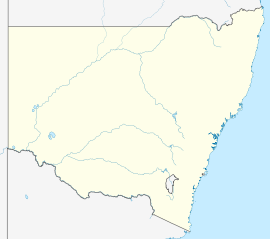
Summary
Tallawang is an historical locality north of Gulgong in central western New South Wales, Australia. The place name is derived from an aboriginal word for "apple gum".[2]
| Tallawang New South Wales | |
|---|---|
 Tallawang | |
| Coordinates | 32°12′S 149°27′E / 32.200°S 149.450°E |
| Population | 165 (SAL 2021)[1] |
| Postcode(s) | 2852 |
| Location | |
| LGA(s) | Mid-Western Regional Council |
| State electorate(s) | Orange |
| Federal division(s) | Parkes |
History edit
The area now known as Tallawang (originally often spelled Tallewang) lies on the traditional lands of Wiradjuri people. [3]
In the 1830s the area was settled by Europeans, originally raising sheep. The Tallawang area is in the valley of Tallawang Creek, which flows south into Wyaldra Creek and then subsequently to the Cudgegong River west of Gulgong.
There was an inn at Tallawang on the track and stock route which is now the Castlereagh Highway. In the 1860s gold was discovered at Tallawang and it became the site of a minor gold rush, overshadowed by the much larger discoveries of gold at Gulgong to the south of Tallawang.
In the late 19th century, many small farms at Tallawang were owned by retired gold miners, and Tallawang had an inn, school, church and stores. A railway station opened in 1910, after the railway line was built from Gulgong to Dunedoo, and was closed in 1974.[4]
In the early 20th century, an iron ore mine operated there, called Tallawang Iron Mines. A government railway line to the quarry was built, and successful ore production commenced in 1911.[5] The ore was railed to Lithgow, where it was smelted in the Lithgow Blast Furnace. The Tallawang Iron Mines closed in February 1927.[6] The mine was worked again from early 1952, with the magnetite ore being crushed and ground and then used in the process of coal washing.[7] This continued up to the 1980s. More recently, underground mining of magnetite has commenced in the area.[8]
Today nothing remains Tallawang.
From 1906, Tallawang was part of the Wyaldra Shire, then the Gulgong Shire, and now is part of the Mid-Western Regional Council area, based at Mudgee.
Notes and references edit
- ^ Australian Bureau of Statistics (28 June 2022). "Tallawang (suburb and locality)". Australian Census 2021 QuickStats. Retrieved 28 June 2022.
- ^ "Tallawang". Geographical Names Register (GNR) of NSW. Geographical Names Board of New South Wales. Retrieved 4 August 2013.
- ^ Studies, Australian Institute of Aboriginal and Torres Strait Islander (10 January 2021). "Map of Indigenous Australia". aiatsis.gov.au. Retrieved 10 December 2021.
- ^ "Tallawang Station". www.nswrail.net. Retrieved 6 July 2023.
- ^ The Daily Telegraph (Sydney NSW) 27 February 1911 edition, page 11, article "In and About the Mines". https://trove.nla.gov.au/newspaper/article/238719972
- ^ "Closed Down. – TALLWANG IRON MINES. VALUABLE INDUSTRY LOST. – Mudgee Guardian and North-Western Representative (NSW : 1890 – 1954) – 17 Feb 1927". Trove. Retrieved 1 June 2020.
- ^ "Old Iron Mine at Tallawang". Mudgee Guardian and North-Western Representative (NSW : 1890 – 1954). 10 January 1952. p. 16. Retrieved 25 September 2020.
- ^ "Tallawang | | MiningLink – The largest & most visited mining website in Australia". mininglink.com.au. Retrieved 1 June 2020.


